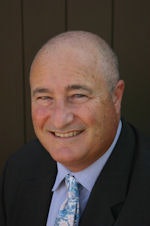
The water was deep and dark as the scuba divers were about to jump from the boat's stern; divers, not diver, because of the buddy system. They knew never to dive alone.
Yet, if you're like most radiology group leaders, you don't think twice about attending -- alone -- a meeting or negotiation session with two or more hospital administrators. Perhaps you, too, need a buddy.
Flashback to college: You're taking Psych 101, and you're required to "volunteer" as the subject of a psych experiment. You step into a room with a group of four other students. The researcher tells you that a series of posters will be shown one at a time, with each poster displaying a number of dark lines, and each of you is to announce which two of the lines are the same length. You're sitting in the fifth position; you'll be asked for your response last.
 |
| Healthcare business and legal affairs expert Mark F. Weiss. |
As the slides begin to progress, it's obvious to you, and to your fellow participants, which two lines match. But then, after a few minutes, the other students begin "matching" another set of lines -- lines that you see as completely mismatched. What match do you announce?
Of course, the other four students are confederates of the researcher and, in this experiment of the type first conducted by Solomon Asch, a Swarthmore College professor, in 1951, were purposely answering incorrectly to see if you would, too. In the Asch experiment, about a third of responses given by the subjects conformed to the erroneous pronouncements of the confederate group. And 75% of the participants agreed with the "mistaken" position of the confederates some of the time.
Many radiology group leaders view themselves as rugged individualists. You've worked hard to get yourself to where you are today, and you're pretty sure -- no, convinced -- that you have a strong personality. You'd never fall sway to group pressure, especially manipulative group pressure.
While that might be true in connection with situations in which you hold obvious power, such as when chairing meetings of your own group, the Asch experiment indicates that, as in scuba diving, there's a lack of safety when outnumbered, even if you know that the others are wrong.
Upon querying the subjects who sided with the confederates, Asch discovered several categories of explanation. Some said that they themselves were wrong and that the others were right, so they agreed. Others said they went along with the incorrect answer in order not to spoil the results. Some said that even though they knew that the others were wrong or acting like sheep, they could not stop themselves from agreeing, too. Finally, some said that they saw their disparate view as a sign of a deficiency that they must hide.
Note that the Asch experiment did not single out weak subjects. He found that in a two-person "group," one confederate and one real subject, the subject was not affected to any real degree. A two confederate to one subject ratio caused the subjects to agree with the erroneous viewpoint close to 14% of the time. But add just one more confederate to the mix, three confederates to one subject, and the subjects' conformity rate more than doubled to almost 32%.
Practical Lessons
Getting back to your meeting with hospital administration, if it's to be one on one with the CEO, assuming your strong personality, there's relatively little danger in being swayed against your will. Consider, though, that most senior hospital administrators are well versed in a range of persuasion techniques and have daily practice deploying them; you probably do not.
Many hospital administrators know better than to meet alone; they love team meetings -- their team of course, with you present. Want to discuss acquiring new imaging equipment? Fine, says the CEO, meet with me at 4:00, and I'll have the chief operating officer, the chief financial officer, and the administrative director of radiology services attend so that we can get their input.
Asch discovered that having even one truthful partner depleted the majority of most of its power.
Before diving into the next meeting with any opposition party, bring along a buddy; in fact, make the buddy system your group's regular meeting paradigm -- but do preparation work first to ensure that your buddy is going to agree with you no matter what. The buddy must understand that the meeting is not an open discussion; his presence is to support, in lockstep fashion, your position.
Better yet, attempt to design encounters that stack the "Asch" odds in your favor. When invited by an administrator to a one-on-one meeting, bring along one or two colleagues to create positive group pressure.
Or, go all the way: Invite the administrator to your department meeting and push for agreement then and there.
By Mark F. Weiss
AuntMinnie.com contributing writer
October 8, 2010
Mark F. Weiss is an attorney who specializes in the business and legal issues affecting radiology and other physician groups. He holds an appointment as clinical assistant professor of anesthesiology at University of Southern California's Keck School of Medicine and practices nationally with the Advisory Law Group, a firm with offices in Los Angeles and Santa Barbara, CA. Mr. Weiss provides complimentary educational materials to our readers. Visit www.advisorylawgroup.com for his free newsletter. He can be reached by e-mail at [email protected].
Related Reading
The Profit Center: Part 15 -- Success requires managing risk, August 13, 2010
The Profit Center: Part 14 -- Accountable care organizations: Accountable to whom? June 10, 2010
The Profit Center: Part 13 -- Radiology as factory work? April 13, 2010
The Profit Center: Part 11 -- Thriving despite (so-called) healthcare reform, January 13, 2010
Copyright © 2010 Mark F. Weiss



















